
Introduction of RCC Column
The whole structure of a building is comprised of different types of components. The column is one of the most important parts of the Framed Structure. Columns are designed to carry the axial loads in compression.
The Columns are used all over the world for the decorative as well as structural purpose. The main function of the columns is to transmit the load of the superstructure to the underground strata.
In this article, you will get to know what are columns, different shapes of columns, types of RCC columns and difference between column and pillar.
What Are Columns?
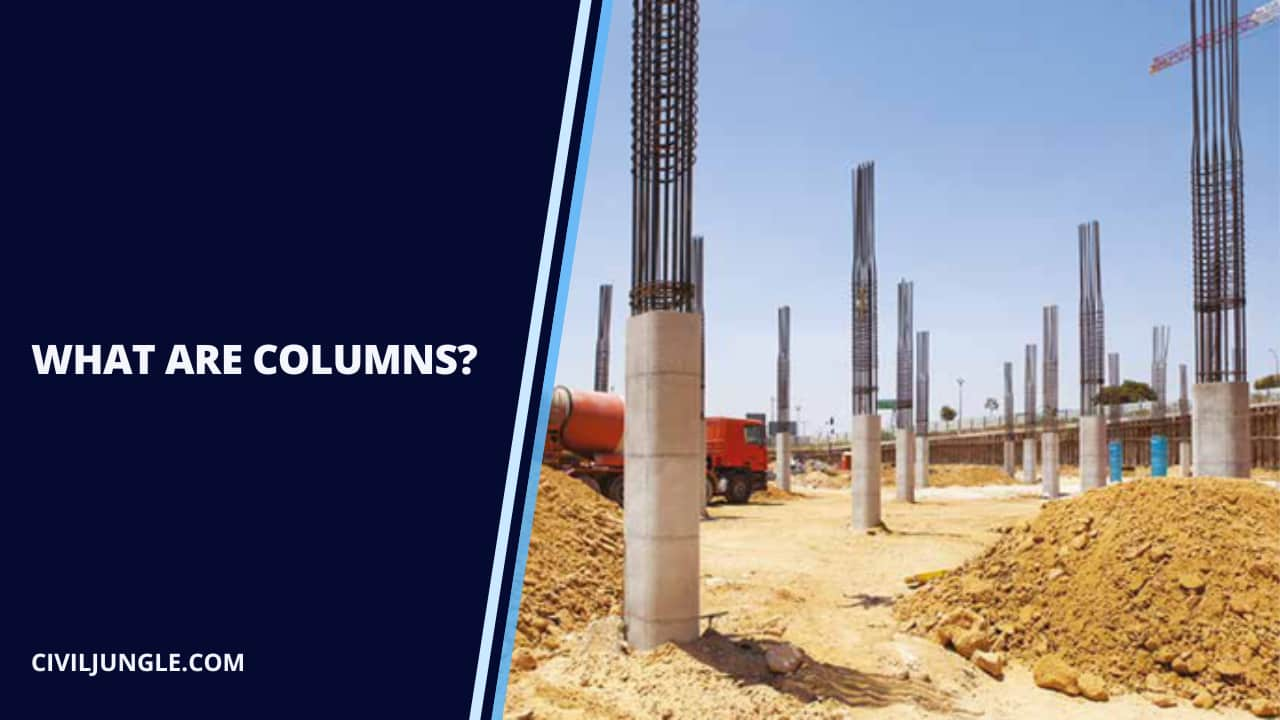
Columns are the vertical Structural member which transmits a load of the slab to the foundation. The column is a rigid vertical structural member.
The effective depth of the column exceeds 3 times the lateral dimension. Generally, column carries the axial loads in the compression. The biaxial column is subjected to the axial compressive force are undergoes to Moments on one or both axes.
Factors on which strength of the column depends
Types of Columns
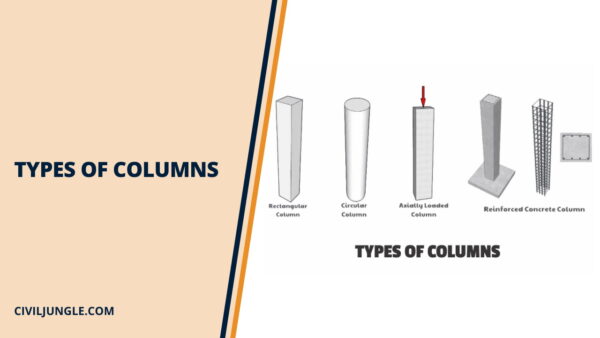
17 different types of column are as follows.
- Square or Rectangular Column: They are commonly used in the construction of buildings and heavy structures. It is much effortless to construct and cast rectangular or square columns than circular ones because of the ease of shuttering and to support it from collapsing due to pressure while the concrete is still in flowable form.
- Circular Column: Circular columns are mostly used in piling and elevation of the buildings for aesthetic purposes. In a circular column, more than 4 longitudinal steel bars are used as a reinforcement bar and its bending resistance is generally higher than the square or rectangular column.
- L and T shaped Column: Generally, the L-shaped column is utilized in the corners of the boundary wall and has similar characteristics of a rectangular or square column. The T-shaped column is utilized based on the design requirements of a structure. It is widely used in the construction of bridges.
- Tied Column: This is usually constructed from reinforced concrete. Longitudinal reinforcements are confined within closely spaced tie reinforcement. If ties are spaced too far apart, the column will experience shear failure and barreling in between ties. It is estimated that 95% of all columns in buildings are tied columns
- Spiral Column: When spiral columns are reinforced with closely and uniformly spaced spiral reinforcement, they are also known as spiral columns. Mostly the spiral columns are providing to support in the transverse direction and prevent the column from barreling. Spirally reinforced columns generally consist of 6 bars as longitudinal reinforcement.
- Composite Column: These columns consist of structural steel or cast iron column enclosed with concrete, reinforced with longitudinal as well as spiral reinforcement. Composite columns are widely used in truss structures to avoid the corrosion of steel. This type of column has more adequate strength with a fairly small cross-section, in addition, to exhibit good fire performance.
- Axially Loaded Column: If vertical axial loads act on the center of gravity of the cross-section of the column, then it is termed as an axially loaded column. The axially loaded column is rare in construction since coinciding vertical loads on the center of gravity of the column section is not practical.
- Uniaxial Eccentrically Loaded Column: The axis of vertical loads doesn’t cross with C.G. (center of gravity) of a cross-section of the column, but rather act eccentrically either on the X or Y axis of the column cross-section, then it is called a uniaxial eccentrically loaded column. A column with this loading system used in the case of columns rigidly connected beam from one side only such as edge columns.
- Biaxial Eccentrically Loaded Column: When vertical loads on the column do not coincide with the center of gravity of the column cross-section and do not act on wither axis (X and Y axis), then the column is called a biaxial eccentrically loaded column. Columns with biaxial loading are mostly used in corner columns with beams rigidly connected at right angles at the top of columns. These types of columns are used in special types of construction.
- Short Column: If the ratio of the effective length of the column to the least lateral dimension is less than 12, the column is called the short column. A short column fails by crushing of the concrete (pure compression failure).
- Long Column: If the ratio of the effective length of the column to the least lateral dimension exceeds 12, it is called a long column. A long column fails by bending or buckling. Long columns are weaker compare to short columns of the same cross-sectional area and not generally preferred.
- Reinforced Concrete Column: A column in which is reinforced with steel are known as reinforced concrete column. This column majorly used in building construction. Concrete is strong in compression and weak in tension. Therefore, steel reinforcement is provided to increase its tension capacity.
- Steel Column: The column which is made from steel is known as steel column. There are huge trends in steel structure construction in the world. The steel structure is comparatively more flexible, strong, and durable than the concrete structure. There are different types of steel columns like the T section steel column which is most commonly used in steel structures.
- Timber Column: A column which is made from timber are known as timber column. Timber columns are popular in the previous century. Timber is mostly seen in the old building because at that time it is only construction materials that are easily available.
- Brick Column: Brick masonry types of columns are generally used in the load-bearing structures. It plays a vital role in supporting and increasing the stability of the masonry structure. Sometimes, the construction of brick masonry columns over the concrete column increases its aesthetic appearance. Brick masonry column may have different cross-sections like round, rectangle or square, or elliptical.
- Block Column: Block types of columns are constructed from AAC block or cement concrete block. The Block column is structural weight is less compared to a concrete column.
- Stone Column: The types of columns in which are made by using stones and rubble are known as the stone column. There are most used to increase the aesthetic appearance of the house.
Types of Columns in Architecture
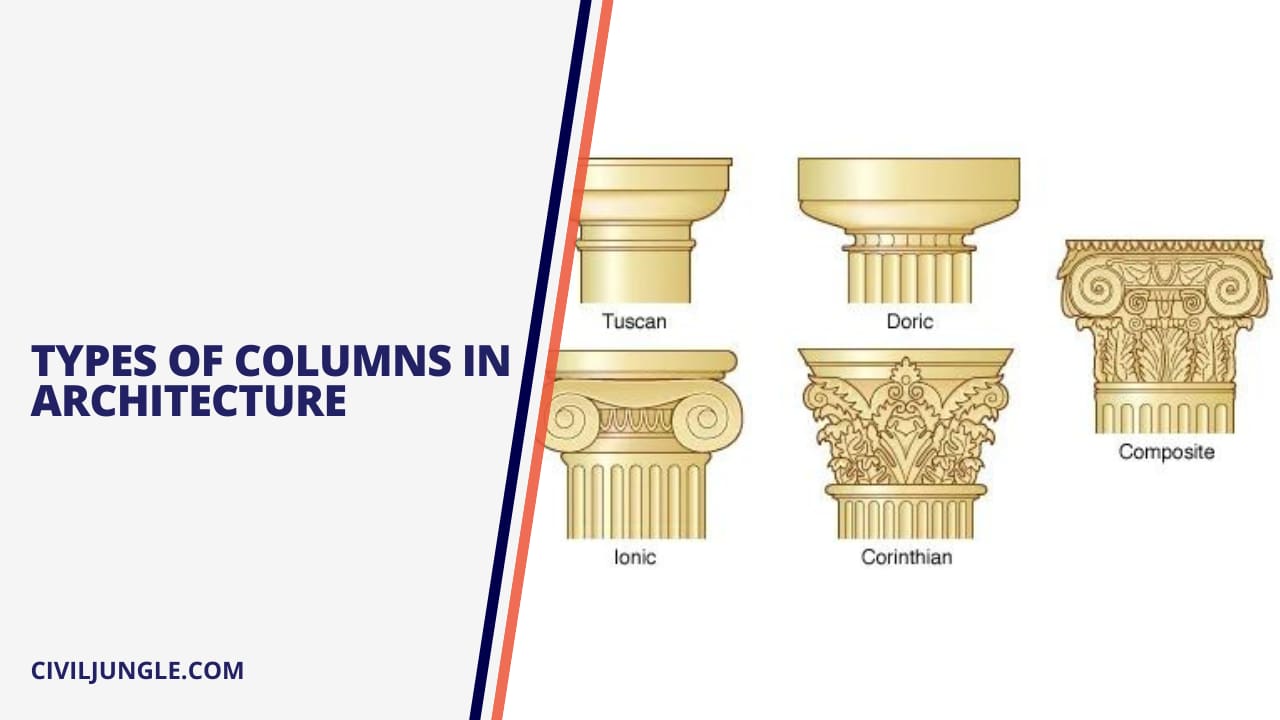
There are five major order of architectural columns used in the construction are as follows
- Doric
- Ionic
- Corinthian
- Tuscan
- Composite
Different Types of RCC Columns
| Sr.No. | Base of Column | Types of Column |
| 1 | Classification of the Column based on its Cross Section. | Square Column or Rectangular Column |
| Circular Column | ||
| T Shape Column | ||
| L Shape Column | ||
| Y Shape Column | ||
| 2 | Classification of the Column based on its Loading. | Axially Loaded Column |
| Axially Loaded and Uniaxial Bending Column | ||
| Axially Loaded and Biaxial Bending Column | ||
| 3 | Classification of the Column based on its Length and Behaviour. | Short Column |
| Long Column | ||
| 4 | Classification of the Column based on its Longitudinal Reinforcement. | Tied Column |
| Spiral Column | ||
| Composite Column |
Columns are classified into different types according to the different criteria are as follows
- Classification of the Column based on its Cross Section.
- Classification of the Column based on its Loading.
- Classification of the Column based on its Length and Behaviour.
- Classification of the Column based on its Longitudinal Reinforcement.
The brief description of the classification of columns given as follows
1. Classification of the Column Based on Its Cross Section.
There are different types of shapes of columns which are used in the construction as per the requirement or design.
- Square Column or Rectangular Column
- Circular Column
- T Shape Column
- L Shape Column
- Y Shape Column
1.1. Square Column or Rectangular Column
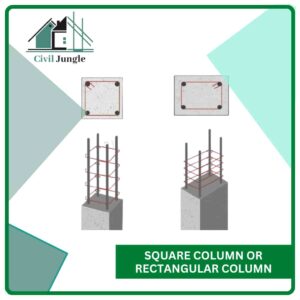
- Square columns or rectangular columns are commonly used in the construction of buildings.
- The construction of the rectangular or square columns is easier and less costly to cast.
- Square or rectangular columns constructed in most of the building structure.
- Significantly both are having the same components, and it differs based on its architect view.
- This type of column was economically good and easy to do shuttering, placing reinforcement & concrete.
1.2. Circular Column
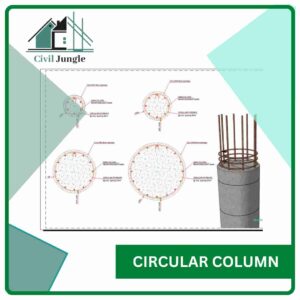
- Circular columns are specially design and widely used in the filing and elevation of the structures.
- Circular columns give a good aesthetical appearance to the structure.
- Circular columns are commonly used in the construction of bridge pillars.
- The circular columns are used when there is no need to construct walls on either side of the column
1.3. T-Shape Column
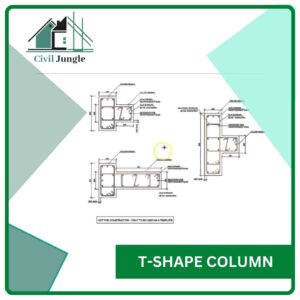
- T-column is used as per the design requirements of the structure.
- Mostly T-Shape columns will be provided along with retaining wall or boundary wall based on the design requirement.
- We knew that the brick or concrete wall-length should not be prolonged more than 6m without placing a column in between.
- If a boundary wall constructed by masonry, then a square or rectangular column is placed in every 6 m. At the same time if it is an RCC type wall, then the column was designed as a T- Shape Column
1.4. L-Shape Column
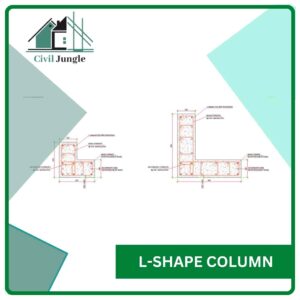
- The L-columns is not commonly used in the structure. It is used at the corner of the frame structure.
- L type column was used in boundary wall construction and used in the turning of metro rail or bridge construction.
1.5. Y-Shape Column

- Generally, these types of columns are mostly used for bridge construction.
- The bridge is designed to sustain the dead load of the structure & live load of the vehicle motion, and the load was eventually distributed to the column.
#2. Classification of the Column Based on Its Loading.
There are different types of loading of columns which are used in the construction as per the requirement or design.
- Axially Loaded Column
- Axially Loaded and Uniaxial Bending Column
- Axially Loaded and Biaxial Bending Column

2.1. Axially Loaded Column
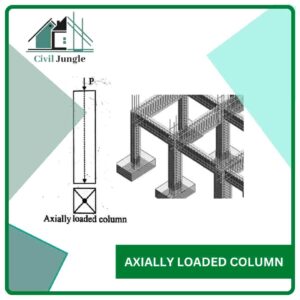
- Axially loaded columns are subjected to the loading which is acting along the longitudinal axis or centroid of the column section.
- A reinforced concrete column is said to be subjected to an axial load when the line of the resultant thrust of loads supported by the column is coincident with the line of C.G. of the column in the longitudinal direction.
2.2. Axially Loaded and Uniaxial Bending Column
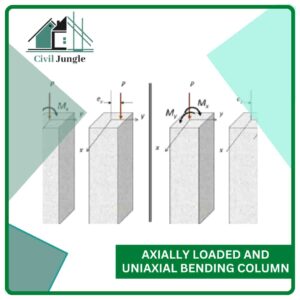
- The axially loaded and uniaxial bending column subject to the loads which do not act on the longitudinal axis of the column section.
- If the column is axially loaded then the steel bar provided in any pattern no matter. But if the column is in uniaxial bending it needs to place the steel bar in the two faces parallel to the axis of bending (strong axis).
- In the case of biaxial bending, we need to place the steel bar all the four faces.
2.3. Axially Loaded and Biaxial Bending Column

- Biaxial bending of columns occurs when the loading causes binding on the principal Axis simultaneously.
- Biaxial bending of columns occurs when the loading causes bending simultaneously about both principal axes.
- The biaxial bending resistance of an axially loaded column can be represented schematically as a surface formed by a series of uniaxial interaction curves drawn radially from the P axis.
#3. Classification of the Column based on its Length and Behaviour.
There are different types of length and behaviour of columns which are used in the construction as per the requirement or design.
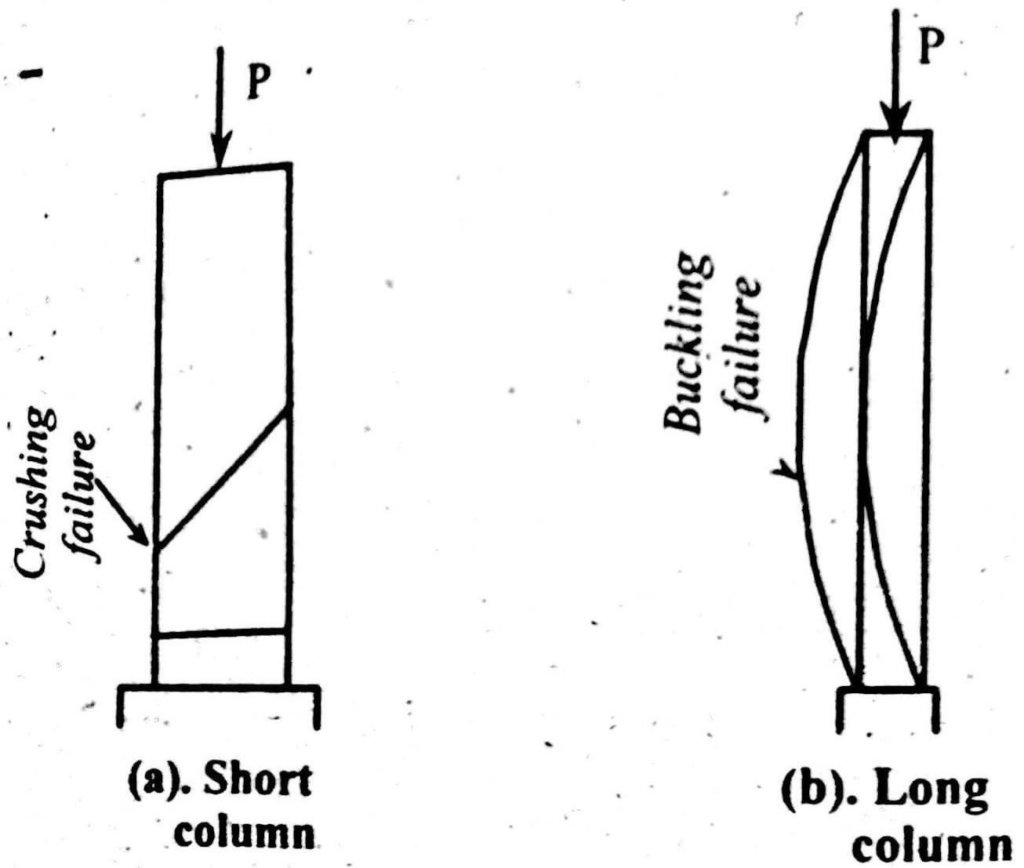
- Short Column
- Long Column
3.1. Short Column
- A short column is the one whose ratio of effective length to its least lateral dimension is less than or equal to 12.
- Then it is termed as a short column.
- lef / b ≤ 12, lef = effective length, b = least lateral dimension of the column.
3.2. Long Column
- Long Column – A long or slender column is the one whose ratio of effective length to its least lateral dimension is not less than 12.
- Then it is termed as a long column.
- lef / b ≤ 12. lef = effective length, b = least lateral dimension of column.
#4. Classification of the Column based on its Longitudinal Reinforcement.
- Tied Column
- Spiral Column
- Composite Column
4.1. Tied Column
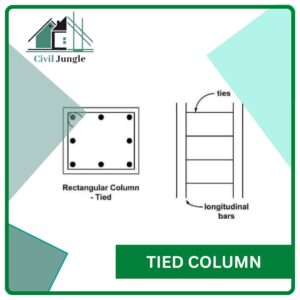
A tied column is a column in which the longitudinal reinforcement bars are tied together with the separate small diameter transverse ties which are spaced at some interval along with the column height.
A tied column, shown in the above figure, is a column in which the longitudinal reinforcement bars are tied together with separate smaller diameter transverse bars (ties) spaced at some interval along with the column height.
The cross-sections of such columns are usually square, rectangular, or circular in shape.
4.2. Spiral Column
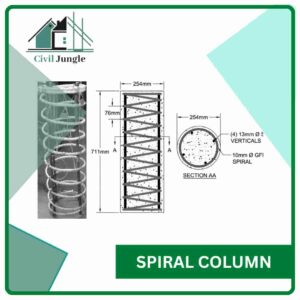
Spiral columns are the columns in which the longitudinal bars are arranged in the circular shape. There is a total of 6 number of bars are used for the longitudinal reinforcement.
In a spiral column, the lateral expansion of the concrete inside the spiral (referred to as the core) is restrained by the spiral.
4.3. Composite Column
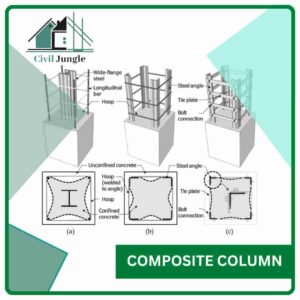
- A composite column is a column which is made of structural Steel shape or pipe which are surrounded by or filled by the concrete with or without longitudinal reinforcement.
- Composite columns are a combination of two traditional structural forms: structural steel and structural concrete.
- As composite columns were generally developed after steel columns and reinforced concrete columns, their design approach could have been based on either steel or concrete design methods.
Round Column Vs Square Column
The Round column and square column are commonly used column shapes in the construction. The difference between the Round column and square are as follows.
| Sr.No. | Round Column | Square column |
| 1 | Round columns are symmetric about centroidal Axis. | Square columns have four-axis of symmetry. |
| 2 | The minimum number of bars which are required in the round columns are 6m. | The minimum number of bars which are required in the square columns are 4m. |
| 3 | A special type of formwork is required for the construction of Round column. | Simple formwork is required for the Construction of square column. |
| 4 | The Construction of the round column is expensive as compared to the square column. | The Construction of square column is economical as compared to the round column. |
| 5 | There are no weak points in the round column due to its circular shape. | The square column has four weak points due to the corner edges. |
| 6 | Round columns are strong in compression so they can carry more load. | Square columns can carry less load as compared to round columns. |
Pillars Vs Columns

Pillar is a vertical structure which is designed to bear the weight of the building’s roof. Pillar is also widely used as a decorative element in Buildings. The column is a structural element which transmits the total load of the structure to the footing and the soil.
Difference Between Pillars and Columns
| Sr.No. | Column | Pillar |
| 1 | Column is a structural member which transmit the total load of the superstructure to the underground Strata. | Pillar is the Structural vertical element which is designed to bear the weight of building roof. |
| 2 | Columns are used to support the load-bearing walls | Pillars are used for the decorative purposes. |
| 3 | In the construction of columns, steel is used. | Steel is not used in the construction of pillars. |
| 4 | All columns are not the pillars | All pillars are the columns |
| 5 | Columns are use to support the load of the component members such as beam and slab. | Pillar can be stand alone or support the roof of the Buildings. |
Frequently Asked Questions (FAQs)
What Is an Rcc Column?
An RCC (Reinforced Cement Concrete) column is a vertical structural member designed to carry axial loads and transmit the load from the superstructure to the foundation. It is reinforced with steel to enhance its strength and durability.
What Are the Different Shapes of Rcc Columns?
RCC columns come in various shapes including square, rectangular, circular, L-shaped, T-shaped, and Y-shaped, each serving specific structural or aesthetic purposes.
What Factors Affect the Strength of an Rcc Column?
The strength of an RCC column depends on several factors including its shape, size, length, and cross-sectional area. Additionally, the quality and quantity of reinforcement and concrete used also play a crucial role.
How Are Rcc Columns Classified?
RCC columns can be classified based on their cross-section (e.g., square, circular), loading conditions (e.g., axially loaded, biaxial bending), length and behavior (e.g., short, long), and longitudinal reinforcement (e.g., tied, spiral, composite).
What Is the Difference Between a Short Column and a Long Column?
A short column has a ratio of effective length to least lateral dimension of 12 or less and typically fails by pure compression. A long column has a ratio greater than 12 and is more prone to bending or buckling failures.
What Is the Distinction Between a Tied Column and a Spiral Column?
A tied column uses transverse ties to confine the longitudinal reinforcement, while a spiral column is reinforced with a continuous spiral of steel around the longitudinal bars, providing better confinement and resistance to lateral forces.
How Do Rcc Columns Differ from Pillars?
While both RCC columns and pillars are vertical supports, columns are primarily structural elements designed to carry loads and transfer them to the foundation. Pillars can also serve decorative purposes and may not always be reinforced with steel.
Why Might Circular Columns Be Preferred Over Square Columns in Certain Designs?
Circular columns are often chosen for aesthetic reasons and for applications where uniform load distribution is beneficial, such as in bridge piers. They generally offer better resistance to bending and less formwork complexity compared to square columns.
What Are Composite Columns and Where Are They Used?
Composite columns are made of structural steel encased in concrete or filled with concrete. They combine the strengths of both materials, offering improved load-bearing capacity and fire resistance. They are often used in high-rise buildings and other structures requiring high strength.
What Are the Key Considerations When Choosing the Type of Rcc Column for a Project?
When choosing an RCC column type, consider the structural load requirements, aesthetic preferences, ease of construction, and the environmental conditions of the project site.

